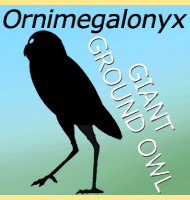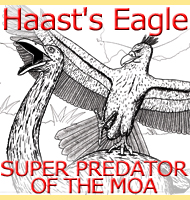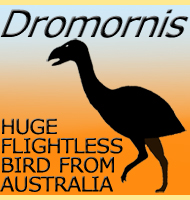


Megalapteryx
(.a.k.a. Upland Moa)
Name:
Megalapteryx.
Phonetic: Meg-ah-lap-teh-riks.
Named By: Julius von Haast - 1885.
Synonyms: Dromornis didinus, Megalapteryx
benhami, Megalapteryx hamiltoni, Megalapteryx hectori,
Megalapteryx huttoni, Megalapteryx tenuipes, Anomalopteryx
didina, Palaeocasuarius, Palaeocasuarius velox, Palaeocasuarius
elegans, Palaeocasuarius haasti.
Classification: Chordata, Aves, Paleognathae,
Dinornithiformes, Megalapterygidae.
Species: M. didinus (type).
Diet: Herbivore.
Size: Just under 1 meter tall.
Known locations: New Zealand, South Island.
Time period: Pleistocene to Holocene, believed to
be extinct by 1500AD.
Fossil representation: Remains of many individuals
including mummified remains of soft tissues and a partial egg.
Though
not as famous as Dinornis,
the Megalapteryx genus is just as if not
even more important to our understanding of moa
birds. Megalapteryx
is one of the few moa, in fact one of the few prehistoric animals,
to be known by mummified remains of soft tissue. Mummification is
essentially where all moisture is drawn out of soft tissue, drying it
out completely. With no moisture content, bacteria that would
normally break down soft tissues cannot take hold, and so what you
are left with is the original soft tissue, now hardened in the near
original form to how it was in life.
The
mummification of some Megalapteryx remains happened
because this genus
of moa is known to have lived in habitats that were as much as two
thousand meters above sea level, hence the more common name of the
genus, the upland moa. At these altitudes the air is not just
thinner, it is also drier, and with the addition of prevailing
winds dehydrating animal remains further as they blow over them, any
animal remains that are not picked clean by scavengers, have a chance
of being mummified. This phenomenon is not unique to New Zealand
however, naturally mummified remains of animals and even people have
been found at high altitudes at locations in Africa, Asia and South
America. On a further side note, high altitudes are not always
necessary for mummification. The famous mummies of Ancient Egypt
originally started out as desert sand burials where the lack of
moisture in the sand caused a similar desiccation of the body, making
it mummified. It was only later in Ancient Egyptian civilisation that
bodies were artificially mummified by placing them in baths of
(presumably dry) natron.
Back
to moa birds, the mummified remains of Megalapteryx
include body
parts such as a foot, leg, head and neck (partially
preserved), and skin. Additional skeletal remains and feathers of
Megalapteryx are also known. Stomach contents and
coprolites of
Megalapteryx have also been identified as being made
up of the fresh
green branches of shrubs and trees, tussock grasses and herbs
associated with semi aquatic environments. The latter is not so
unusual, since high altitude streams would feed into pools and
perhaps even small lakes and these may have been the only permanent
sources of fresh water at such high elevations.
Uplands
habitats not only have thinner air but are generally more exposed to
prevailing winds, two factors that can greatly reduce the ambient
temperature. This is probably why Megalapteryx is
noted for having a
greater amount of feathers that also insulated the lower legs, feet,
and head. Only the beak and soles of the feet were devoid of
feathers. In forest dwelling genera, the lower legs and possibly
the head in some had no feathers, probably because they were living
in warmer and more moist environments.
The
Megalapteryx genus is also a good indicator for
how moa probably
did not carry their heads and necks totally erect and upright. More
modern reconstructions concerning Megalapteryx,
indicate that the
head was probably carried near horizontally level to the back. This
would actually make more sense since most of the plants that
Megalapteryx fed upon were low growing. A neck
held closer to the
level of the body would also not be so exposed to prevailing winds,
making it easier for Megalapteryx to maintain body
temperature in the
cooler climates of its habitats.
Remains
of eggs of Megalapteryx are also known, and
appear to have been dark
olive-green in their colouration. There is speculation though that
the colour of egg shells may have varied slightly between individuals.
Megalapteryx individuals are expected to have laid
about one or two
eggs at a time which were then cared for by male birds. This would
hint at a K-strategy survival method where a parent bird makes a
concerted effort at rearing a small number of young rather than raising
many young and relying upon weight of numbers to carry the species
through.
The
Megalapteryx genus was originally described as a
species of Dinornis,
D. didinus, by Richard Owen in 1883. Two
years later this
species was used as the basis for establishing the then new genus of
Megalapteryx. Like with many other moa genera,
Megalapteryx was
once treated as something of a ‘waste basket taxon’ and ended up
with more species names than as was necessary. As of 2013 the
only species of Megalapteryx recognised as valid is
M. didinus.
Further reading
- Mummified moa remains from Mt Owen, northwest Nelson -
Notornis 36 (1): 36–38. - Trevor H. Worthy - 1989.
- Unique, dark olive-green moa eggshell from Redcliffe Hill,
Rakaia Gorge, Canterbury - Notornis 39 (1): 63–65.
- Beverley McCulloch - 1992.
- Plant remains in coprolites: diet of a subalpine moa
(Dinornithiformes) from southern New Zealand. - Emu Austral
Ornithology - Mark Horrocks, Donna D'Costa, Rod Wallace, Rhys
Gardner & Renzo Kondo - 2004.
----------------------------------------------------------------------------
Random favourites
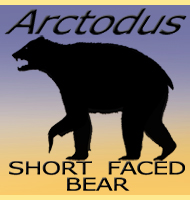 |
 |
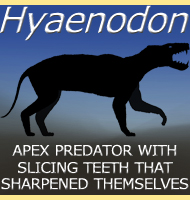 |
 |
